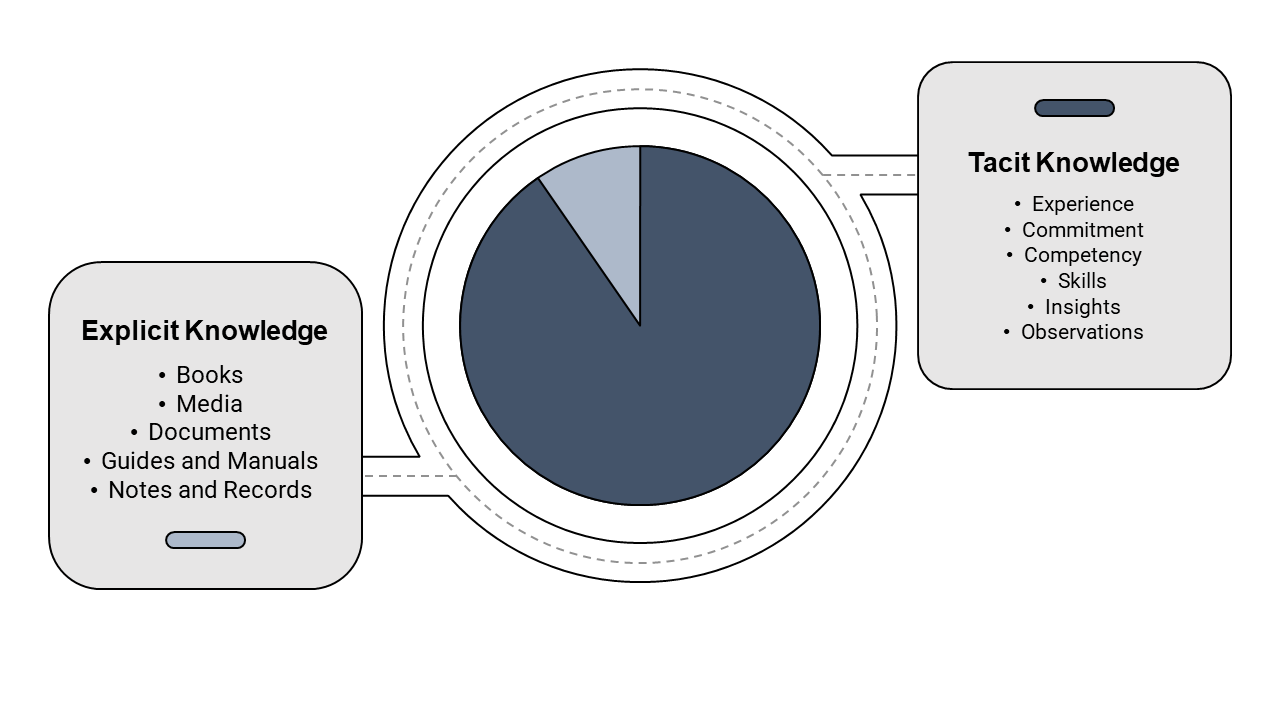Tacit Knowledge – Know Tricks and Techniques of the Knowledge Elicitation Process
Introduction
Knowledge is a paramount asset in any organization. Specifically, within an IT service company, the knowledge management process assumes a crucial role, encompassing creation, storage, growth, and sharing. It acts as a safeguard, ensuring uninterrupted operations for end customers and eliminating the risk of a single point of failure in day-to-day activities.
In today’s knowledge-driven world, we can broadly classify knowledge into two types: Explicit and Tacit. While explicit knowledge can be readily shared through books, media, and documents, tacit knowledge, which stems from experience and competency, remains locked within individuals’ minds.

Figure 1: Difference between Tacit Knowledge and Explicit Knowledge
The challenge lies in effectively transferring this valuable tacit knowledge during transitions. A real-world example underscores this issue: I encountered a significant obstacle during my experience executing a crucial transition for a major energy utility company. Over 20% of subject matter experts (SMEs) were set to retire, taking decades of essential knowledge. Despite the team’s efforts to complete the transition amid the challenges of the COVID-19 pandemic, the absence of disseminated tacit knowledge posed risks to the company’s core operations. To avoid such situations, it becomes imperative for organizations to prioritize tacit knowledge management and distribution early on, ensuring smooth transitions and safeguarding business continuity.
Addressing pain points and trends
In the quest for organizational excellence, knowledge-sharing and distribution play a pivotal role in shaping success. However, current practices and beliefs often hinder efficient tacit knowledge management and dissemination. Addressing this situation requires a closer look at the behavioral and cultural aspects of the organization surrounding knowledge distribution as below:
- Incentivize knowledge sharing: There is a noticeable absence of a culture that rewards individuals for sharing their knowledge. Such incentives are either lacking entirely or if they exist, they are rarely implemented consistently.
- Leadership priorities: Many leaders are deeply committed to their roles and have demanding schedules. They may face challenges in allocating time for knowledge distribution. The importance of knowledge sharing is realized when they are compelled to switch vendors and explore opportunities to enhance organizational performance.
- Vendor organization perspective: The same issue applies from the perspective of vendor organizations. If tacit knowledge is disseminated in various forms from the beginning, such as having backup personnel or storing it as scenario-based recordings, it would be immensely valuable in preventing a single point of failure during situations like a global pandemic.
- Concerns over status: Some individuals are concerned that sharing their knowledge might affect their role as critical or dependable members of the organization. They worry about how it may impact their performance ratings, career progression, and perceived value within the organization. Finding a way to balance these concerns with the benefits of knowledge sharing is essential. Encouraging a collaborative culture involves addressing these concerns and highlighting the collective benefits of knowledge exchange.
Enhancing knowledge distribution: Effective techniques and benefits
- Acknowledgement of existence: The first step is acknowledging its existence and value. This awareness sets the foundation for a knowledge-sharing culture.
- Defining tacit knowledge through K-map: Creating a Knowledge Map (K-map) helps identify and categorize tacit knowledge, making it easier to understand and share within the organization.
- Skill-gap assessment: Regularly assessing skill gaps within the project team helps organizations identify areas for improvement in knowledge distribution.
- Hands-on exercises: Hands-on exercises in the presence of SMEs and knowledge-sharing sessions are very effective in acquiring tacit knowledge from them.
- Using experienced resources: During knowledge transfer, onboarding experienced resources to interact with SMEs can help extract knowledge by asking pertinent questions.
- Observe, follow, practice: To deal with such challenges, use contextual learning built around observe, follow, and practice, mixed with a learning experience.
- Interview-based knowledge acquisition: Interviewing experienced personnel enables the extraction of valuable tacit knowledge. This technique facilitates knowledge transfer from experts to other team members.
- Expert intervention: Involving experts during knowledge transitions provides invaluable insights and guidance, ensuring the smooth transfer of tacit knowledge.
- Tools for tacit knowledge extraction: Leveraging technological tools aids in capturing and documenting tacit knowledge, facilitating its accessibility and utilization across the organization.
- Seek help from power users: Engaging with proficient power users helps identify hidden pockets of tacit knowledge and promotes its dissemination among others.
Barriers to receiving client support
To effectively acquire tacit knowledge, organizations must address certain barriers while seeking support from clients:
Change management: Implementing a knowledge-sharing culture may face resistance from individuals accustomed to hoarding knowledge. Effective change management strategies are essential to overcome such resistance and foster collaboration.
Hostility: Some team members might harbor reservations about sharing their knowledge, fearing the loss of their perceived value. Open communication and a supportive environment can help alleviate hostility and encourage participation.
Expectation setting: Setting clear expectations from the outset, both within the organization and with clients, is crucial for successful knowledge acquisition and transfer.
Illustrating the strategies through a case study
An energy company in the USA faced a significant knowledge transfer challenge during a crucial transition. This was compounded by the pandemic’s impact and the retirement of over 20% of experienced SMEs. To overcome this hurdle, we implemented several low-effort, high-impact tactics:
Small changes, big impact:
- Building comfort: We initiated discussions between highly experienced consultants and SMEs, focusing on industry trends and sharing their experiences. This eased SMEs into the transition process, fostering effective knowledge transfer.
- Parallel knowledge transfer: Instead of the traditional sequential approach, we conducted knowledge acquisition and shadowing simultaneously. This proved highly effective, as our consultants could address issues independently during the shadowing phase.
- Comprehensive documentation: We recorded 100% of the knowledge transfer sessions to prevent the loss of critical knowledge.
- Post-transition documentation: We agreed to defer documentation to the stabilization phase for expediency in certain areas where SMEs were retiring early.
These approaches highlight how collaboration and innovative strategies can help organizations overcome barriers to knowledge acquisition and transfer.
Conclusion
In the immediate future, addressing the challenge of acquiring tacit knowledge during knowledge acquisition remains a complex and critical endeavor. The primary objective is to gather as much tacit knowledge as possible during transitions. However, it is essential to acknowledge that certain aspects of tacit knowledge develop over time, and instant access might be limited. This recognition calls for a balanced approach, where organizations foster a knowledge-sharing culture that values explicit and tacit knowledge. Organizations can enhance their performance, adaptability, and resilience by promoting continuous learning and collaboration. Embracing this approach will facilitate seamless knowledge transfer and lay the foundation for sustained success in an ever-changing business landscape.
Disclaimer
Data on file: The statistics presented in this point of view are derived from in-house research, findings, and client interactions.
More from Om Mohanty
IT costs have become increasingly difficult to control as organizations have become more dependent…
Latest Blogs
he supply chain is a network of suppliers, factories, logistics, warehouses, distributers and…
Introduction What if training powerful AI models didn’t have to be slow, expensive, or data-hungry?…
Pharmaceutical marketing has evolved significantly with digital platforms, but strict regulations…
Leveraging the right cloud technology with appropriate strategies can lead to significant cost…




